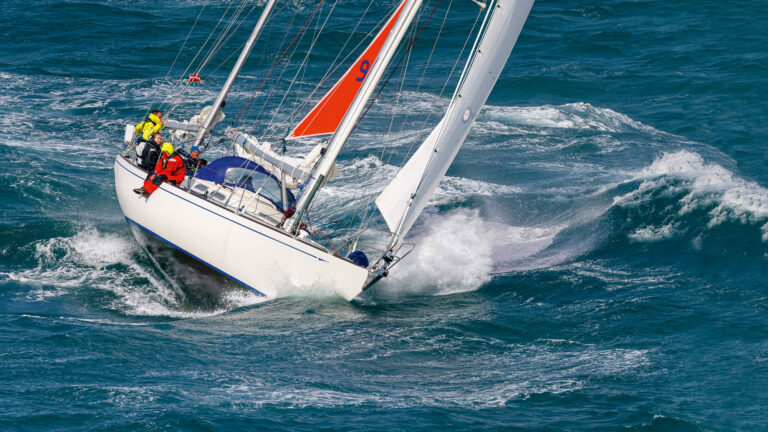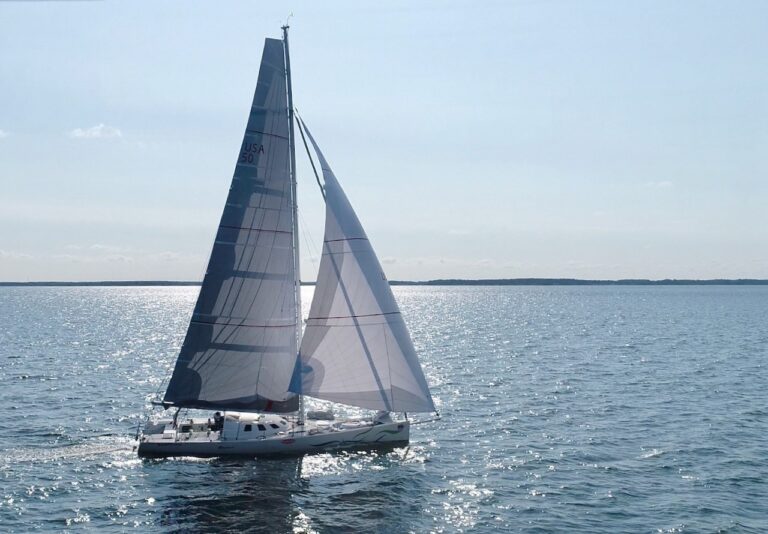Harnessing the Wind: Advanced Sailing Tactics
Harnessing the wind’s advanced sailing tactics involves sailing at a course of around 45 degree angles to the oncoming wind and alternating the wind’s direction between the port and starboard side through a technique called “tacking.” This allows ships to sail against the wind and reach their desired destination efficiently.
Lateen sails, the astrolabe, and the magnetic compass were crucial innovations that enabled ships to sail into the wind by providing better navigation capabilities. These advancements allowed ancient sailors to navigate the seas, just as sailors do today. By harnessing the wind effectively, sailors can maneuver and sail against the wind to their advantage, overcoming the challenges posed by wind direction.
Understanding The Basics Of Sailing Against The Wind
Learn the basics of sailing against the wind and master the art of harnessing the wind for advanced sailing tactics. Discover the strategies of tacking and alternating the direction of the wind to sail efficiently even when facing headwinds.
Exploring The Concept Of Sailing Against The Wind:
Sailing against the wind, also known as upwind or beating, is a fundamental skill in sailing that involves maneuvering a sailboat in a direction opposite to the wind. While it may seem counterintuitive, skilled sailors can harness the power of the wind and navigate effectively against it.
To understand the concept of sailing against the wind, let’s explore the basics:
- Head-to-wind: When the bow of the boat is directly facing the wind, the sails will luff, losing power and causing the boat to stall. Sailing upwind requires maintaining a course that is slightly off the wind to maintain sail power and forward momentum.
- Close-hauled: To sail upwind effectively, sailors must sail as close as possible to the direction from which the wind is coming. This “close-hauled” position allows the boat to make progress against the wind by generating lift forces on the sails.
- Tacking: Tacking is the process of changing direction to make progress against the wind. It involves turning the bow of the boat through the wind, switching the sails from one side to the other. By alternating the direction of the boat between the port (left) and starboard (right) side, sailors can zigzag their way upwind.
- Beating angles: When sailing upwind, the optimal sailing angle to the oncoming wind is usually around forty-five degrees. However, the actual angle may vary depending on factors such as wind speed, boat type, and wind conditions. Skilled sailors constantly adjust their course and sail trim to find the most efficient angle for their particular boat.
- Sail trim: Proper sail trim is crucial when sailing upwind. By adjusting the sails’ shape, tension, and angle relative to the wind, sailors can optimize their boat’s performance and maximize forward propulsion. Experimenting with different sail settings and paying attention to telltales (small ribbons or strings on the sails) helps sailors find the perfect balance between power and efficiency.
- Boat handling techniques: Sailing upwind requires precise boat handling skills. Sailors must anticipate wind shifts, adjust their course promptly, and maintain a balanced heel angle to optimize their boat’s performance. Advanced techniques such as weight distribution, body positioning, and efficient use of the tiller or helm also play a crucial role in sailing against the wind.
Understanding the basics of sailing against the wind is essential for any sailor looking to master advanced sailing tactics. By learning the art of tacking and making constant adjustments to sail trim and boat handling, sailors can unlock the true potential of their sailboats and navigate effectively in challenging upwind conditions.
Keep practicing and honing your skills, and you’ll become a proficient upwind sailor in no time.
Utilizing Advanced Sail Designs For Optimal Performance
To optimize performance on the water, advanced sail designs are utilized to harness the wind in sailing tactics. These innovative designs allow ships to sail against the wind, thanks to the use of triangular lateen sails and other navigation tools like the astrolabe and magnetic compass.
Introduction To Innovative Sail Designs
In the world of sailing, advancements in technology have led to the development of innovative sail designs that optimize performance on the open water. These cutting-edge designs make use of a combination of aerodynamics, materials, and engineering principles to maximize speed and maneuverability.
In this section, we will explore the benefits of lateen sails for sailing against the wind and delve into the role of aerodynamics in sail design.
The Benefits Of Lateen Sails For Sailing Against The Wind:
Lateen sails have long been favored by sailors for their ability to harness the wind efficiently, particularly when sailing against it. Here are some of the key benefits associated with lateen sail designs:
- Versatility: Lateen sails are highly versatile and can be adjusted to various wind conditions. This flexibility allows sailors to adapt their sails to different angles and speeds, optimizing their performance on the water.
- Upwind Performance: Lateen sails excel at sailing upwind, thanks to their unique triangular shape. This design enables the sails to generate lift, propelling the boat forward even when sailing against the wind. It allows sailors to navigate their vessels efficiently and maintain a steady course.
- Maneuverability: The triangular shape of lateen sails also enhances maneuverability. These sails allow sailors to tack easily, changing the direction of the boat by crossing the bow through the wind. This maneuver is crucial for sailing against the wind and is made easier with the help of lateen sails.
Understanding the role of aerodynamics in sail design:
Aerodynamics plays a crucial role in sail design, as it determines how sails interact with the wind and generate lift. Here are some key aspects to consider when it comes to the aerodynamics of sail design:
- Lift and Drag: The shape and curvature of a sail determine its ability to generate lift and minimize drag. A well-designed sail maximizes lift to propel the boat forward while minimizing drag, allowing for optimal performance.
- Twist and Angle of Attack: Sail design involves careful attention to the angle of attack and twist. The angle of attack refers to the angle at which the sail meets the wind, while the twist refers to the variation in the angle of attack along the length of the sail. These factors affect the efficiency of the sail in different wind conditions and angles.
- Sail Materials: Advanced sail designs also take into account the materials used in construction. Lightweight, high-strength materials can enhance overall performance by reducing weight and increasing durability.
By understanding the role of aerodynamics in sail design, sailors can make informed decisions about sail shape, angle, and materials to achieve optimal performance on the water.
Harnessing the power of innovative sail designs is essential for sailors looking to maximize their performance on the water. Lateen sails offer specific advantages for sailing against the wind, while considering the principles of aerodynamics ensures sails are designed to generate lift and minimize drag.
With these advanced sail designs, sailors can navigate the open waters with precision and speed.
Navigational Tools For Successful Windward Sailing
Discover the navigational tools necessary for successful windward sailing and learn advanced tactics for harnessing the power of the wind. Upgrade your sailing skills with these valuable techniques.
The Astrolabe: A Crucial Tool For Navigation:
- The astrolabe is an ancient navigational tool used by sailors to determine their latitude.
- It consists of a metal disk with markings representing celestial bodies and a rotating arm used to measure angles.
- By observing the position of the sun or stars and comparing it to the markings on the astrolabe, sailors could accurately calculate their latitude at sea.
- This information was vital for successful windward sailing, as it helped sailors stay on the desired course and avoid getting off track.
The Magnetic Compass And Its Impact On Sailing Against The Wind:
- The introduction of the magnetic compass revolutionized navigation, especially for windward sailing.
- The magnetic compass uses a magnetized needle to point towards the Earth’s magnetic North, allowing sailors to determine their heading.
- This was crucial for sailing against the wind, as sailors could maintain a consistent heading, regardless of the wind direction.
- By using the compass, sailors could adjust their course accurately and make tactical decisions to optimize their progress against the wind.
Utilizing Modern Navigation Technology For Enhanced Windward Sailing:
- Modern navigation technology has significantly enhanced windward sailing techniques.
- GPS (Global Positioning System) is a valuable tool that provides accurate position data, enabling sailors to navigate with precision.
- Weather forecasting apps and websites provide real-time wind information, helping sailors plan their routes effectively.
- Sail trim sensors and wind instruments enable sailors to monitor and optimize their sail settings for maximum performance against the wind.
- With the aid of these modern navigation tools, sailors can make informed decisions, adjust their strategies, and successfully navigate against the wind.
Remember, windward sailing requires careful planning, knowledge of navigational tools, and adaptability to changing conditions. By utilizing the astrolabe, magnetic compass, and modern navigation technology, sailors can harness the wind’s power and excel in windward sailing.
Advanced Techniques For Sailing Upwind
Learn advanced techniques for sailing upwind and harnessing the wind with these advanced sailing tactics. Discover how to optimize your sailing angle and use tacking to reach your desired destination while sailing against the wind. Improve your sailing skills with these expert strategies.
Maximizing Boat Speed Through Proper Sail Trim:
- Properly trimming the sails is crucial for maximizing the boat’s speed when sailing upwind.
- Here are some key points to consider for proper sail trim:
- Mainsail: Adjust the mainsail by tightening or loosening the mainsheet. A properly trimmed mainsail will have a smooth, even shape with no wrinkles or flapping.
- Headsail: Trim the headsail by adjusting the sheets. The headsail should be trimmed so that it is flat and the telltales (small ribbons attached to the sail) are streaming straight back.
- Twist: Pay attention to the twist in the sails. The top of the sail should be slightly more open than the bottom to allow the wind to flow smoothly over the sail.
Understanding The Role Of Crew Weight And Balance:
- Crew weight and balance play a significant role in sailing upwind effectively.
- Here are some important factors to consider:
- Weight distribution: Distribute the weight of the crew members evenly throughout the boat. This helps maintain stability and prevents excessive heel.
- Fore and aft weight: Adjust the crew’s position to balance the boat. Move crew weight forward in lighter winds to help the boat point higher and keep the bow down. In heavier winds, move crew weight aft to reduce weather helm and increase balance.
- Sideways weight: Keep crew weight positioned to windward to counterbalance the force of the wind on the sails and prevent excessive heeling.
Using Heel Angle To Optimize Windward Performance:
- The heel angle of the boat can greatly impact its windward performance. Optimizing the heel angle can help improve upwind sailing.
- Consider the following points when adjusting the heel angle:
- Angle of heel: Aim for a slight heel rather than sailing completely flat. This helps increase the boat’s stability and reduces drag.
- Weather helm: Adjust the heel angle to decrease weather helm. Weather helm is the natural tendency of the boat to turn into the wind, and excessive heel can exacerbate this effect.
- Sail power: The correct heel angle can help balance the power in the sails. Too much heel can result in excessive heeling and loss of control, while too little heel can result in reduced power and slower progress upwind.
By implementing proper sail trim, understanding crew weight and balance, and optimizing the heel angle, you can enhance your sailing performance when sailing upwind. Remember that practice and experience are key to mastering these advanced sailing tactics. So get out on the water, experiment, and see what works best for your boat and crew!
Mastering The Art Of Tacking For Efficient Windward Sailing
Learn the art of efficiently navigating windward sailing with advanced tactics for harnessing the wind. Discover the techniques of tacking, alternating the direction of the wind between the port and starboard side, to sail against the wind and reach your desired destination.
The Importance Of Proper Tacking Technique
Tacking is a crucial maneuver in sailing that allows sailors to make headway against the wind. Mastering the art of tacking is essential for efficient windward sailing. Here are some key points on the importance of proper tacking technique:
- Maintaining momentum: Proper tacking technique allows sailors to maintain their boat’s momentum, ensuring that they continue to move forward even when sailing into the wind.
- Changing tack smoothly: By executing tacking maneuvers correctly, sailors can smoothly shift their boat’s direction from one side of the wind to the other, without losing significant speed.
- Effective use of the sails: Proper tacking technique involves skillfully adjusting the sails to take advantage of the wind’s force during each maneuver. This allows for efficient use of the wind’s power and maximizes the speed gained during tacking.
Timing And Coordination During Tacking Maneuvers
Timing and coordination are crucial aspects of successful tacking maneuvers. Here are some key points to consider:
- Anticipate the wind: Before initiating a tack, sailors should carefully observe the wind direction and strength. This enables them to time their maneuvers effectively and minimize speed loss.
- Coordination between crew members: Tacking requires seamless coordination between the skipper and the crew. The crew’s role includes releasing and trimming the sails at the appropriate moments to ensure a smooth transition.
- Communication: Effective communication is vital during tacking maneuvers. Clear and concise instructions from the skipper to the crew ensure that everyone is on the same page, leading to better coordination and fewer errors.
Strategies For Minimizing Speed Loss During Tacking
Minimizing speed loss during tacking is crucial for maintaining a competitive edge in sailing races. Here are some strategies to consider:
- Optimal helm balance: Maintaining optimal balance between the rudder and the sails during a tack helps minimize speed loss. This involves anticipating the shift in wind direction and adjusting the rudder angle accordingly.
- Maintaining speed through the tack: Sailors can minimize speed loss by utilizing proper sail trim throughout the tack. This involves adjusting the sails’ position to maintain maximum power while transitioning between windward and leeward sides.
- Minimizing distance traveled: By efficiently planning the tack and executing it accurately, sailors can minimize the distance traveled during the maneuver. This reduces the time spent sailing at an unfavorable angle to the wind and helps maintain higher average speeds.
Remember, mastering the art of tacking takes practice and experience. By understanding the importance of proper technique, timing, coordination, and using effective strategies, sailors can make significant improvements in their windward sailing performance.

Credit: goldengloberace.com
Tactical Decision-Making For Windward Sailing
With advanced sailing tactics, windward sailing requires tactical decision-making to harness the wind effectively. By alternating the direction of the wind between the port and starboard side through tacking, sailors can efficiently sail against the wind at optimal angles for reaching their desired destination.
Assessing Wind Conditions And Choosing The Most Favorable Route:
- Consider the wind direction and speed to determine the best course of action.
- Analyze the current wind patterns to identify any shifts or gusts that could impact your sailing.
- Look for signs of changing weather conditions that may affect the wind, such as approaching storm clouds or a front.
- Evaluate the lay of the land, including any geographic features that can create wind channels or eddies.
- Choose a route that takes advantage of favorable wind angles, allowing for efficient sailing.
Analyzing Current And Tide Patterns For Strategic Advantage:
- Understand the influence of currents and tides on your sailing performance.
- Study tide charts to identify the best times for sailing, taking into account both high and low tides.
- Determine the direction and strength of the current to plan your route accordingly.
- Take advantage of tidal patterns, such as using an outgoing tide to help sail against the wind.
- Adjust your tactics based on the interaction between the wind and the current, aiming for optimal speed and efficiency.
Adjusting Tactics Based On The Performance Of Competing Boats:
- Observe the strategies and tactics employed by other boats in your race or regatta.
- Pay attention to the performance of faster or more experienced boats to learn from their tactics.
- Assess the strengths and weaknesses of your competitors to develop a winning strategy.
- Make real-time adjustments to your own tactics based on the performance of competing boats.
- Stay adaptable and open to new approaches, constantly refining your tactics throughout the race.
Remember, advanced sailing tactics rely on a combination of skill, experience, and a deep understanding of wind patterns. By assessing wind conditions and choosing the most favorable route, analyzing current and tide patterns for strategic advantage, and adjusting tactics based on the performance of competing boats, you can harness the wind to gain a competitive edge in your sailing endeavors.
Weather Forecasting For Windward Sailing
Windward sailing requires advanced sailing tactics and a keen understanding of weather forecasting. By harnessing the wind and strategically altering the direction of the sails, sailors can navigate against the wind and make the most efficient use of their vessel’s capabilities.
Understanding The Impact Of Weather Systems On Sailing Against The Wind:
- Windward sailing refers to the technique of sailing against the wind, which requires understanding the impact of weather systems on the boat’s performance.
- Weather systems such as high and low-pressure systems, fronts, and localized conditions can significantly influence the strength, direction, and stability of the wind.
- Understanding how these weather systems interact with each other and affect wind patterns is crucial for successful windward sailing.
- Factors such as wind speed, wind shifts, gusts, and varying wind angles play a vital role in determining the optimal course to counteract the challenges of sailing against the wind.
Interpreting Weather Forecasts For Optimal Windward Performance:
- Interpretation of weather forecasts is essential for planning windward sailing strategies to achieve optimal performance.
- Weather forecasts provide crucial information about wind direction, wind speed, atmospheric pressure, and the possibility of weather changes during a sailing trip.
- By understanding and analyzing this information, sailors can anticipate wind shifts, plan their tacking strategies, and make informed route decisions.
- Identifying weather patterns, predicting favorable wind angles, and selecting the best time to set sail are key considerations based on accurate weather forecast interpretation.
- Being able to adapt and adjust sailing plans according to the forecasted weather conditions can significantly improve windward performance.
Preparation And Adaptation Strategies For Changing Weather Conditions:
- Changing weather conditions can pose challenges during windward sailing, requiring sailors to be prepared and adaptable.
- Prior to setting sail, sailors should conduct thorough pre-trip planning by assessing weather forecasts, understanding local weather patterns, and identifying potential challenges along the windward route.
- Carrying necessary safety equipment and proper gear for varying weather conditions is crucial to ensure the crew’s well-being and the boat’s stability.
- Monitoring weather conditions during the sailing trip and staying updated on any changes in wind speed, wind direction, or the development of weather systems is essential.
- Having contingency plans and alternative routes in place allows for quick adaptation to changing weather conditions, ensuring a safe and successful windward sailing experience.
Remember, understanding the impact of weather systems, interpreting weather forecasts, and preparation for changing weather conditions are all essential elements of successful windward sailing. By applying these strategies, sailors can optimize their performance and navigate against the wind with confidence.
Racing Tactics For Windward Sailing
Discover advanced racing tactics for windward sailing and gain an edge in harnessing the wind. Learn how to optimize your sailing angle and effectively tack to reach your desired destination. Master the art of sailing against the wind and improve your overall performance on the water.
Key Strategies For Competitive Windward Sailing:
- Positioning is crucial in windward sailing. Here are some key strategies to consider:
- Play the shifts: Stay alert and adapt your course based on changes in wind direction. Anticipate wind shifts and make quick adjustments to maintain the most favorable angle to the wind.
- Cover your competition: Keep an eye on your closest competitors and try to stay between them and the next mark. This helps minimize their chances of overtaking you.
- Balance speed and height: Find the optimal balance between sailing as close to the wind as possible (height) and maintaining good speed. Experiment with sail trim and boat settings to find the sweet spot.
Maneuvering For Advantageous Positions On The Racecourse:
- To gain an edge over your competitors, it’s important to maneuver strategically for advantageous positions on the racecourse. Here’s what you can do:
- Start tactics: Make a solid start by positioning yourself in clear air and avoiding crowded areas. This allows you to have more control over your course and speed.
- Use wind shadows: Take advantage of wind shadows created by larger boats or obstructions on the racecourse. By positioning yourself in these areas, you can disrupt your competitor’s wind flow and gain an advantage.
- Play the shifts smartly: Analyze wind patterns and adjust your tactics accordingly. Look for persistent shifts or localized changes in wind velocity and use them to your advantage.
Using Tactical Moves To Gain An Edge Over Competitors:
- In windward sailing, employing tactical moves can give you a significant advantage over your competitors. Here are some effective maneuvers to consider:
- Ducking and overstanding: By intentionally sailing slightly below or above a competitor, you can create overlap and gain control over their leeward position, making it harder for them to pass.
- Tacking on top: If you notice a competitor sailing on a lifted tack, consider tacking on top of them to force them into a less favorable position. This move can disrupt their momentum and allow you to take the lead.
- Strategic cover: If you’re leading the fleet, strategically cover your competitors by staying close to them and forcing them to follow your moves. This puts pressure on them to make decisions that may not be ideal for their performance.
Remember, windward sailing requires constant attention to wind shifts, smart tactics, and the ability to outmaneuver your competitors. By employing these key strategies and using tactical moves effectively, you can greatly increase your chances of success on the racecourse.
Safety Considerations For Windward Sailing
For windward sailing, safety considerations are crucial. Harnessing the wind requires advanced sailing tactics such as tacking, where alternating the direction of the wind between the port and starboard side is necessary to reach a specific point. Implementing these tactics ensures a safe and smooth sailing experience.
Preparing For Challenging Windward Conditions:
Sailing windward can be an exhilarating experience, but it also requires careful preparation and consideration of safety measures. Here are some key points to keep in mind before venturing into challenging windward conditions:
- Understand the weather forecast: Before setting sail, check the weather forecast for the wind speed and direction. This will help you anticipate the conditions you’ll encounter and prepare accordingly.
- Check your boat’s equipment: Ensure that your boat is in good condition and that all equipment, such as rigging, sails, and safety gear, is properly maintained. This will help prevent any unexpected issues during windward sailing.
- Adjust your sail plan: Depending on the wind strength, you may need to reef your sails or adjust their trim. Be familiar with the different sail configurations and know how to reduce sail area when necessary.
- Plan your course: Determine the most efficient route to your destination, taking into account wind shifts and currents. Proper navigation and strategic planning can make windward sailing more manageable and enjoyable.
- Communicate with your crew: It’s essential to establish clear communication with your crew members before and during windward sailing. Assign roles and responsibilities, discuss maneuvers, and ensure everyone understands the safety procedures.
Remember, adequate preparation is key to a successful windward sailing experience. By considering these factors, you’ll be better equipped to handle challenging conditions and ensure the safety of yourself and your crew.
Safety Precautions For Strong Winds And Rough Seas:
When sailing windward, encountering strong winds and rough seas is a possibility. It’s crucial to prioritize safety and take the necessary precautions to avoid any potential hazards. Here are some safety measures to consider when facing these conditions:
- Wear appropriate safety gear: Always wear a well-fitting life jacket or personal flotation device (PFD) when sailing in challenging windward conditions. This will ensure your safety if you are unexpectedly thrown overboard.
- Secure loose items: Before setting sail, stow away any loose items on deck or in the cabin to prevent them from becoming dangerous projectiles during high winds or rough seas.
- Establish a communication plan: Have a clear communication plan in place with your crew, including hand signals or radio protocols, to ensure effective communication even in challenging conditions.
- Maintain situational awareness: Pay close attention to your surroundings and constantly monitor changing weather and sea conditions. This will allow you to anticipate any potential risks and take appropriate action.
- Reduce sail area: If the wind becomes too strong, consider reducing sail area by reefing or changing to a smaller headsail. This will help maintain control and stability.
- Use proper seamanship techniques: Employ proper seamanship techniques such as heaving-to, using drogues, or deploying a sea anchor if necessary. These techniques can help stabilize the boat and keep it on course in challenging windward conditions.
By following these safety precautions, you can navigate strong winds and rough seas with confidence and minimize any potential risks during windward sailing.
Emergency Procedures For Windward Sailing Incidents:
Despite taking all the necessary precautions, emergencies can still occur during windward sailing. It’s essential to be prepared and know what actions to take in case of an incident. Here are some emergency procedures to keep in mind:
- Man overboard situation: If someone falls overboard, execute a quick and efficient man overboard recovery procedure. Immediately alert the crew, deploy a floatation device, and initiate a rescue plan while continuously keeping visual contact with the person in the water.
- Capsizing or keel failure: In the event of a capsize or keel failure, staying calm is crucial. Communicate with the crew and focus on self-rescue techniques, such as deploying life rafts or activating emergency signaling devices.
- Equipment failure: If there’s a failure in critical equipment, assess the situation and prioritize safety. Activate backup equipment if available, and be prepared to make necessary repairs or adjustments to ensure the safety of the vessel and crew.
- Emergency communication: Maintain reliable means of communication, such as a VHF radio or satellite phone, to call for assistance if needed. Be familiar with emergency channels and protocols for distress calls.
Remember, remaining calm, communicating effectively, and acting swiftly are vital during emergencies. Regular practice, drills, and crew training can significantly enhance your ability to respond to challenging situations during windward sailing.
As you embark on your windward sailing adventures, keep these safety considerations in mind. By being well-prepared and knowing what to do in various situations, you can enjoy the thrill of windward sailing while ensuring the safety of yourself and your crew.
Frequently Asked Questions Of Harnessing The Wind: Advanced Sailing Tactics
What Is The Most Efficient Way To Sail Against The Wind?
To sail against the wind efficiently, sailors use a technique called tacking. They alternate the direction of the wind between the port and starboard side of the boat. This allows them to reach their destination while sailing into the wind.
What Innovation Allowed For Ships To Sail Against The Wind?
The innovation that allowed ships to sail against the wind was the use of lateen sails.
How Did Ancient Sailors Sail Against The Wind?
Ancient sailors sailed against the wind by tacking, changing the direction of the wind between the port and starboard side.
How Can A Sailboat Sail Faster Than The Wind?
Sailboats sail faster than the wind by tacking off the wind and adjusting their rig and keel.
Conclusion
Degrees of the wind. They would sail at an angle, called tacking, to utilize the wind’s force and reach their desired destination. This technique, along with the use of lateen sails, the astrolabe, and the magnetic compass, allowed ancient sailors to sail against the wind and navigate more effectively.
Advanced sailing tactics are essential for modern sailors as well. By understanding the principles of harnessing the wind and employing strategic techniques, sailors can optimize their speed and maneuverability. These tactics include proper sail trim, adjusting the angle of attack, and anticipating wind shifts.
Harnessing the wind is a skill that requires practice, experience, and a deep understanding of the dynamics of sailing. By mastering advanced sailing tactics, sailors can confidently navigate challenging wind conditions and maximize their performance on the water. So, whether you’re a beginner or an experienced sailor, learning these techniques will undoubtedly enhance your sailing adventures and make you a more competent seafarer.
Embrace the wind, embrace the challenge, and set sail towards new horizons with the power of advanced sailing tactics.








